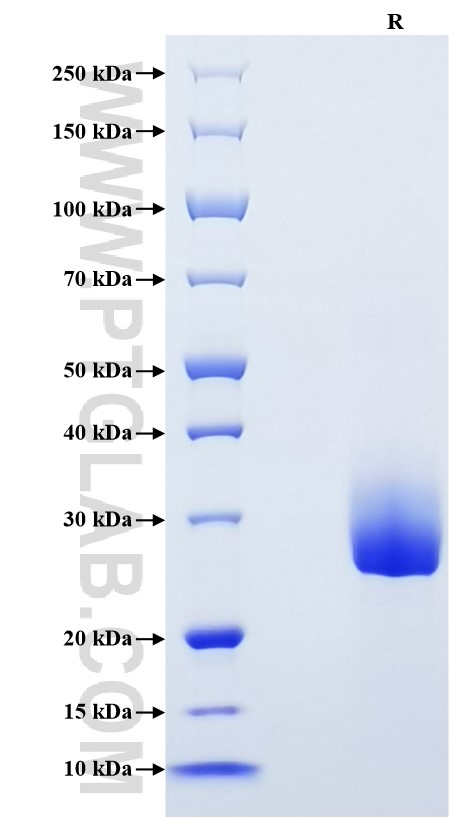Recombinant Human IL-6 protein (Myc Tag, His Tag)
ED50
/
Species
Human
Purity
>90 %, SDS-PAGE
GeneID
3569
Accession
P05231
验证数据展示
Technical Specifications
| Purity | >90 %, SDS-PAGE |
| Endotoxin Level | <1.0 EU/μg protein, LAL method |
| Biological Activity |
Not tested |
| Source | HEK293-derived Human IL-6 protein Val30-Met212 (Accession# P05231) with a Myc tag and a His tag at the C-terminus. |
| Predicted Molecular Mass | 25.8 kDa |
| SDS-PAGE | 25-30 kDa, reducing (R) conditions |
| Formulation | Lyophilized from sterile PBS, pH 7.4. Normally 5% trehalose and 5% mannitol are added as protectants before lyophilization. |
| Reconstitution | Briefly centrifuge the tube before opening. Reconstitute at 0.1-0.5 mg/mL in sterile water. |
| Storage |
It is recommended that the protein be aliquoted for optimal storage. Avoid repeated freeze-thaw cycles.
|
| Shipping | The product is shipped at ambient temperature. Upon receipt, store it immediately at the recommended temperature. |
Background
Interleukin-6 (IL-6) is an interleukin that acts as both a pro-inflammatory and anti-inflammatory cytokine. IL-6 protein is secreted by a variety of cell types including T cells and macrophages as phosphorylated and variably glycosylated molecule. IL-6 Plays an essential role in the final differentiation of B-cells into Ig-secreting cells involved in lymphocyte and monocyte differentiation. It induces myeloma and plasmacytoma growth and induces nerve cells differentiation Acts on B-cells, T-cells, hepatocytes, hematopoietic progenitor cells and cells of the CNS. IL-6 is also considered a myokine, a cytokine produced from muscle, and is elevated in response to muscle contraction. IL-6 has been shown to interact with interleukin-6 receptor and glycoprotein 130. Additionally, IL-6 is involved in hematopoiesis, bone metabolism, and cancer progression, and has been defined an essential role in directing transition from innate to acquired immunity.
References:
1. Scheller J. et al. (1988). Behring Inst Mitt. Behring Inst Mitt. (83):40-7. 2. Heinrich PC. et al. (2003). Biochem J. 374: 1-20. 3. Rose-John S. et al. (2007). Expert Opin Ther Targets. 11: 613-24. 4. Ming JE. et al. (1989). J Mol Cell Immunol. 4: 203-11. 5. Febbraio MA. et al. (2005). Exerc Sport Sci Rev. 33:114-9. 6. J Appl Physiol. et al. (2005). J Appl Physiol. 98:1154-62.
